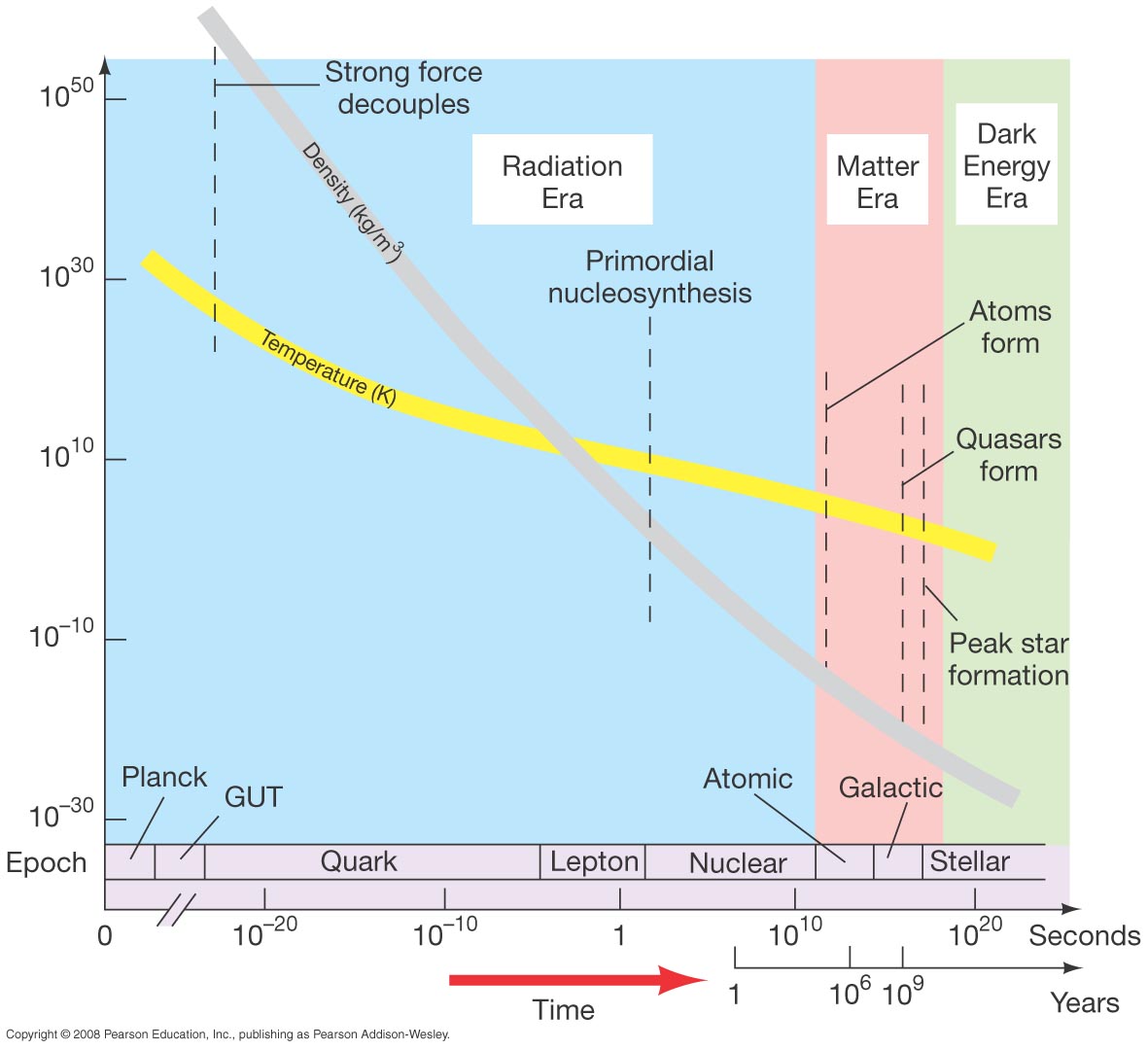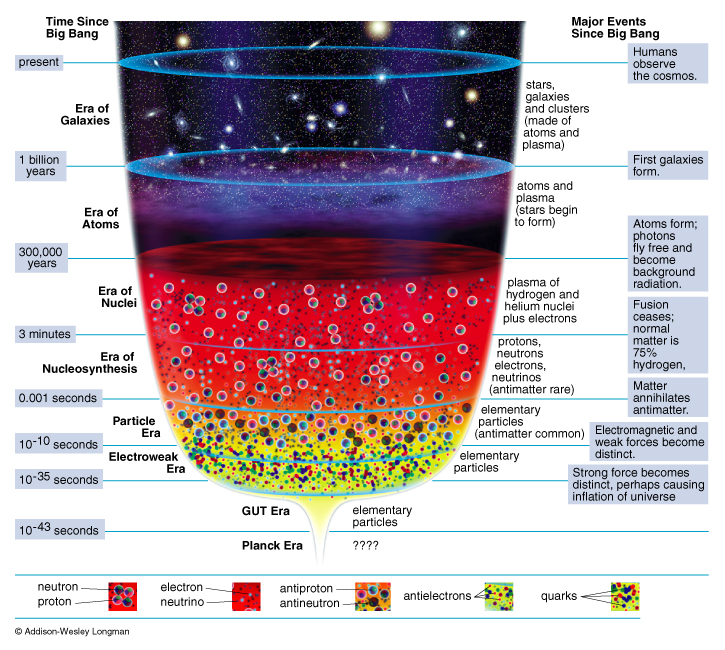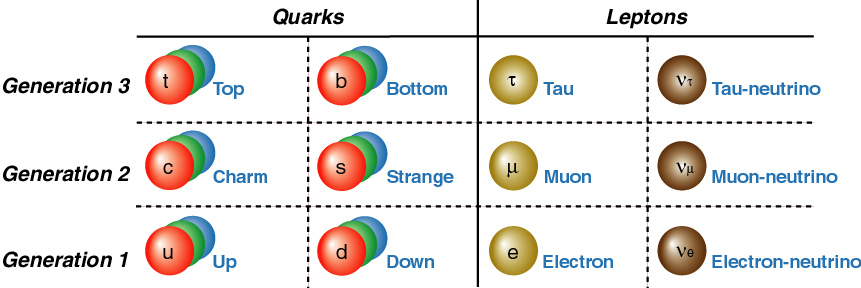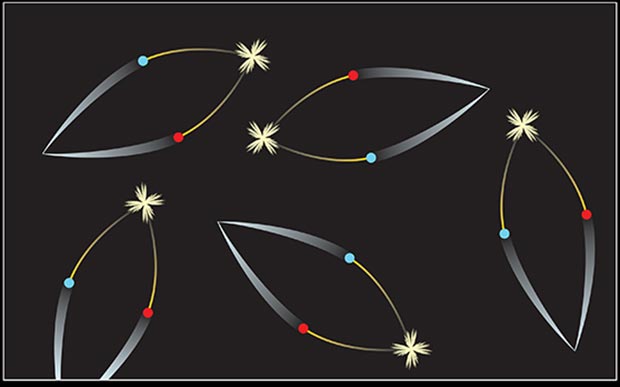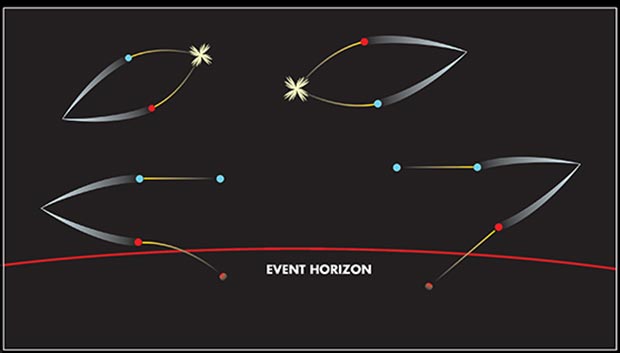A. 0 → 10-43 seconds, the Planck Era
|
The
Planck era when the four forces of the Universe -- the
gravitational,
electro-magnetic,
strong (nuclear), and
weak forces -- may have been
unified. This is the era of quantum gravity -- the time when a theory
which encompasses both quantum mechanics and gravity must be used.
The size of the current Universe at this time is less
than 10-50 centimeters.
B. 10-43 → 10-36 seconds,
Era of the GUT and Beginning of Inflation
|
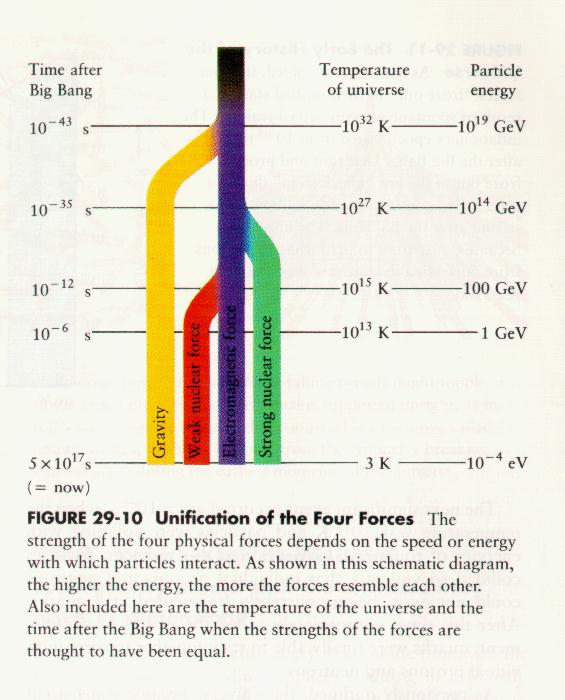
|
Era of the
Grand Unified Theories (GUTs), which is after
gravity separates from the
other 3 forces (i.e., gravity becomes an interaction distinct from
the electromagnetic, strong (nuclear) and weak (nuclear)
forces). The GUT era ends after around
10-32 seconds have elapsed after the
beginning of the Universe. At this time the Universe has
a temperature of 1027-1028 Kelvin.
Inflation begins at the end of
the GUT stage --
inflation is
driven by an, as of now, unknown repulsive force. We describe
inflation in the next section.
|
C. 10-36 → 1 second, Inflation, the
Quark Epoch, and On to
Element Production, Nucleosynthesis
|
The strong (nuclear) force becomes a distinct interaction at the
beginning of this stage and
inflation stops at the beginning of this stage.
During inflation, the Universe increases in size by
a huge factor.
The size of the current Universe is currently believed to have increased
in size by arond a factor of
1050 during inflation.
A region around the size of the Planck length
(~ 4x10-33 cm) expands enough during inflation
to encompass more than the currently
observable Universe.
Pair Production and Annihilation
After inflation, the Universe continues to expand.
The Universe is still
exceedingly hot, T > 1015 Kelvin and very energetic. The high-energy
radiation is very energetic. This has important consequences. In his
Special Theory of Relativity,
Einstein showed that there is an
equivalence between mass and energy, E = mc2
.
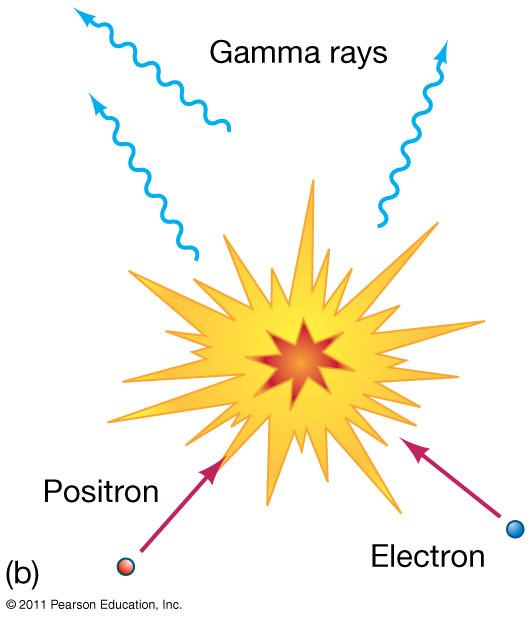 |
Equivalence of Mass and Energy,

and the conservation of mass and energy in the Universe. |
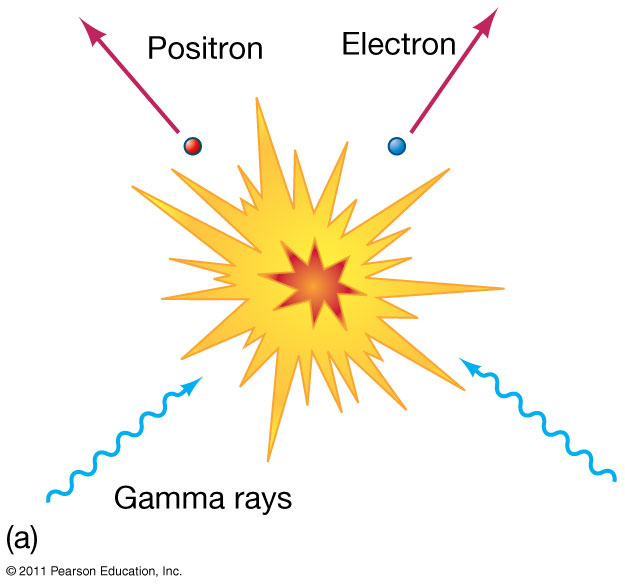 |
This means that high-energy radiation can transform into
particles if the radiation is energetic enough.
Interestingly, the production always
produces pairs of particles, one an ordinary particle and the other
its anti-matter twin. In the
inverse process, matter particles and their anti-matter twins
annihilate
and release energy (radiation)!
The matter particle and its anti-matter twin are nearly identical, the primary difference lying
in their electrical properties. For example, an electron has
a negative charge while its anti-matter twin,
the anti-electron or positron, has a positive charge.
When the Universe is very hot,
pair production
of the fundamental particles quarks and
leptons
occurs.
Something odd happens during this time, however, because for an unknown
reason more matter quarks and leptons are produced than anti-matter
quarks and anti-matter leptons, even though they should always be created
in matter/anti-matter pairs. The slight excess of matter over anti-matter
leads to the outcome that there is matter in our Universe today.
|
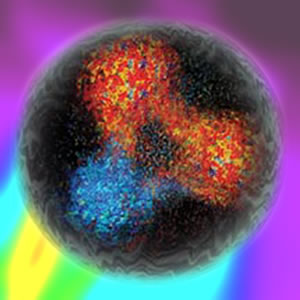 |
After inflation the Universe is dominated by a
quark-gluon plasma. What are
quarks and gluons? To the left is
a schematic picture of what is known as a baryon.
Baryons are a class of fundamental particles
which includes protons
and neutrons
(see rigtht); protons and neutrons are
composed of three quarks
held together by the intermediary particles known as
gluons.
When the Universe is very hot and energetic, the
quarks and gluons are free and are not tied up in
baryons.
|
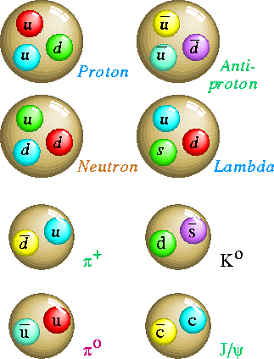 |
As the Universe
expands it cools.
After around around ~ 10-11 seconds
hve elapsed, the temperature is around ~ 1015
Kelvin and the weak nuclear force and the electromagnetic force
become distinct (a further symmetry breaking.
We now have a universe dominated by the four known
forces of the Universe, the gravitational force, the strong nuclear
force, the weak nuclear force, and the electromagnetic force.
From this time on, we are rather secure in our understanding of the
Universe. The conditions in the Universe from here onward are attainable in
Terrestrial laboratories and so amenable to detailed experimental study.
Around 10-6 seconds after the birth of the Universe,
quarks and gluons combine to form
baryons (neutrons and protons).
This marks the end to the
Quark Epoch.
The production of baryons continues until the temperature drops below
1013 Kelvin where the Universe is no longer energetic enough to
produce baryonic matter/anti-matter pairs.
Unfortunately, there is no barrier
to annihilations of matter/anti-matter pairs and the annihilation process
continues quite efficiently. As noted earlier, we are lucky in that
there was a slight asymmetry between matter and anti-mattter quarks and
leptons which allows some matter baryons to survive the annihilation!
The production of the matter baryons is
referred to as baryogenesis while
the existence of the slight excess of matter over anti-matter
referred to as the
Matter-Anti-Matter Asymmetry Problem.
Because electrons are less massive than baryons, the similar event for electrons
and their anti-matter twins, the positrons, occurs later, around ~1 second
after the birth of the Universe when the temperature has
dropped below 1 billion Kelvin.
D. 1 second → 100 seconds, Nucleosynthesis and
the Nuclear Epoch |
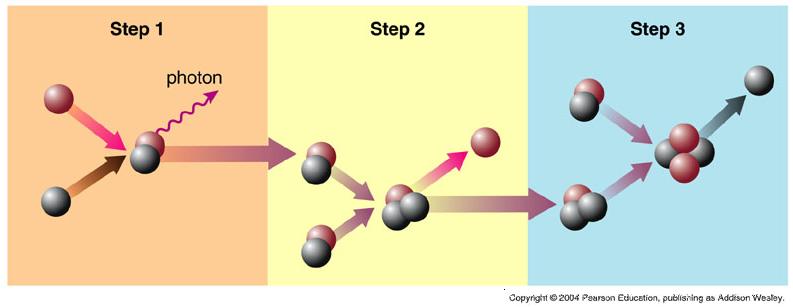
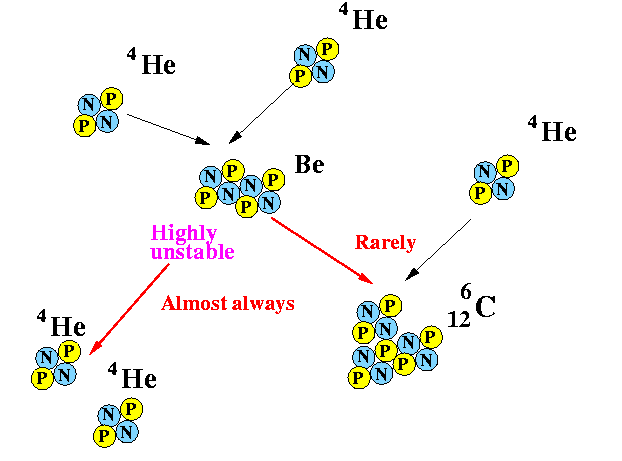
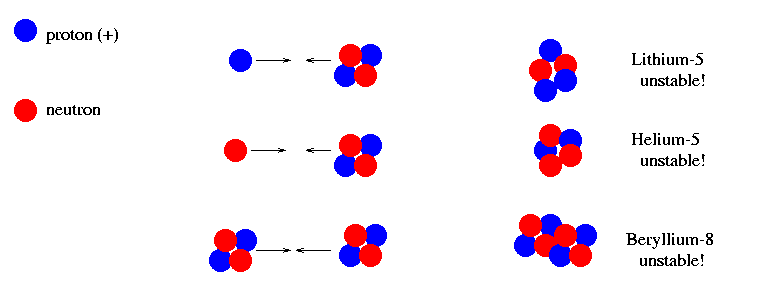
| Big Bang Nucleosynthesis
The final symmetry breaking has already occured by this time
(at time 10-11seconds);
quarks and gluons have combined to form protons;
protons and electrons combined to form neutrons; and the stage is set for the
formation of the elements in a process referred to as
nucleosynthesis.
In nucleosynthesis,
hydrogen, helium, a little
lithium and the
hydrogen isotope
deuterium are produced in the
few minutes after 1 second has elapsed into
evolution of the Universe. The
top panel shows how helium nuclei are produced
from four hydrogen nuclei (protons). The middle panel shows how the larger,
more massive element Carbon may be produced. This
chain almost never completes in the early Universe because the intermediate
step where Beryllium forms leads to a bottleneck.
Beryllium decays (breaks
apart into helium nuclei) after 6.710-17 seconds, way too fast for
it capture another helium nucleus. |
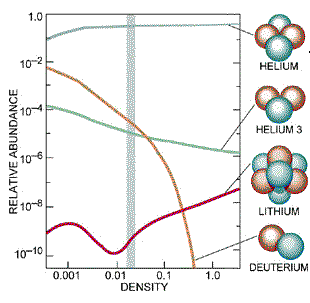 |
In Big Bang Nucleosynthesis, only
hydrogen, helium, lithium and the hydrogen isotope
deuterium are produced in significant amounts
(see the figure to the left).
The amount of helium produced in the Big Bang
is insensitive
to the mass contained in baryons in the Universe,
but the amount of deuterium is very
sensitive to the mass in baryons in the Universe.
Based on current
measurements of the primordial abundances of
hydrogen, helium, and deuterium, we infer
that the amount of normal matter which can be contained in the
Universe is 3-4 % of the critical density (the gray bar in the figure
to the left)! After the finish of the era of
nucleosynthesis, the
Universe continues to expand and cool but no new chemical elements are created
until stars form and die. |
E. 380,000 years → Formation of
Cosmic Microwave Background Radiation
|
Recombination and the CMB
The Universe becomes cool and rarefied enough for electrons and protons
to form neutral hydrogen atoms. This occurs around when the temperature of
the Universe has dropped to around 3,000 Kelvin (z ~ 1,100).
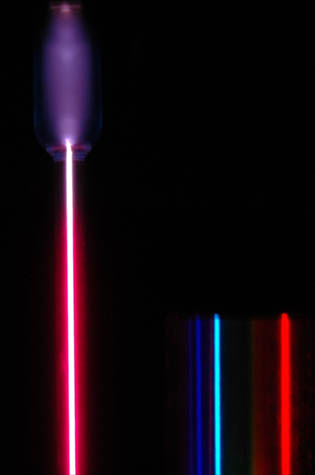 | Hydrogen gas is not an
efficient absorber of light and so the Universe becomes transparent.
To understand look at the figure to the left which shows a
tube that contains hydrogen gas and the spectrum of the tube at the
lower right. An electric
current is run through the tube exciting the hydrogen atoms causing
them to radiate. Notice that the hydrogen atoms produce only certain colors
(wavelengths) of light. Absorption being the inverse of emission means that
the same hydrogen atoms will absorb only the same colors of light which it
emits. Most of the light impinging on hydrogen gas is unaffected by
the presence of the gas! |
Before the Era of Recombination
, the Universe was
opaque to radiation, that is, the Universe was "foggy" in that
light could not travel very far which meant
that our view of the Universe was limited. After
Recombination, the Universe cleared up, it became transparent
and our view of the Universe was unimpeded.
What are the consequences of this? |

|
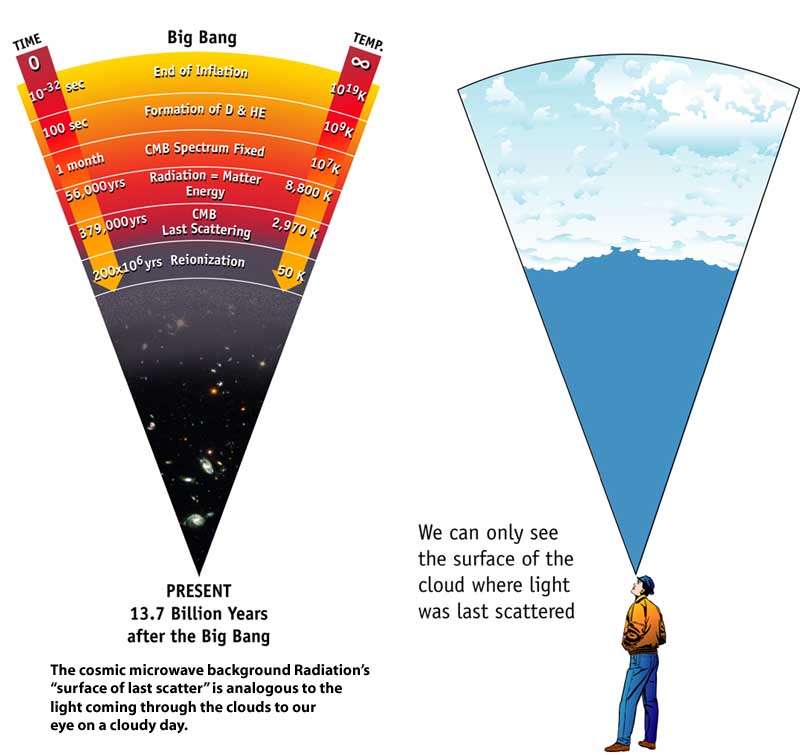 |
After
Recombination, we can get
unimpeded view of the distant Universe. So, as the Universe gets older,
we can see further and further into the past. However, we cannot see
forever because at some point the Universe becomes opaque; we can only see
up to Recombination, that is, we can see the
Universe as it was 378,000 years after the Big Bang.
This is what we see when we observe
the Cosmic Microwave Background Radiation, the CMB.
This ia analogous to the situation we encounter when we see
the light from a cloud in the sky. We see the clear space between the
cloud and us, but we cannot see into the dense, opaque part of the cloud.
|
Temperature Variations in the Cosmic Microwave Background
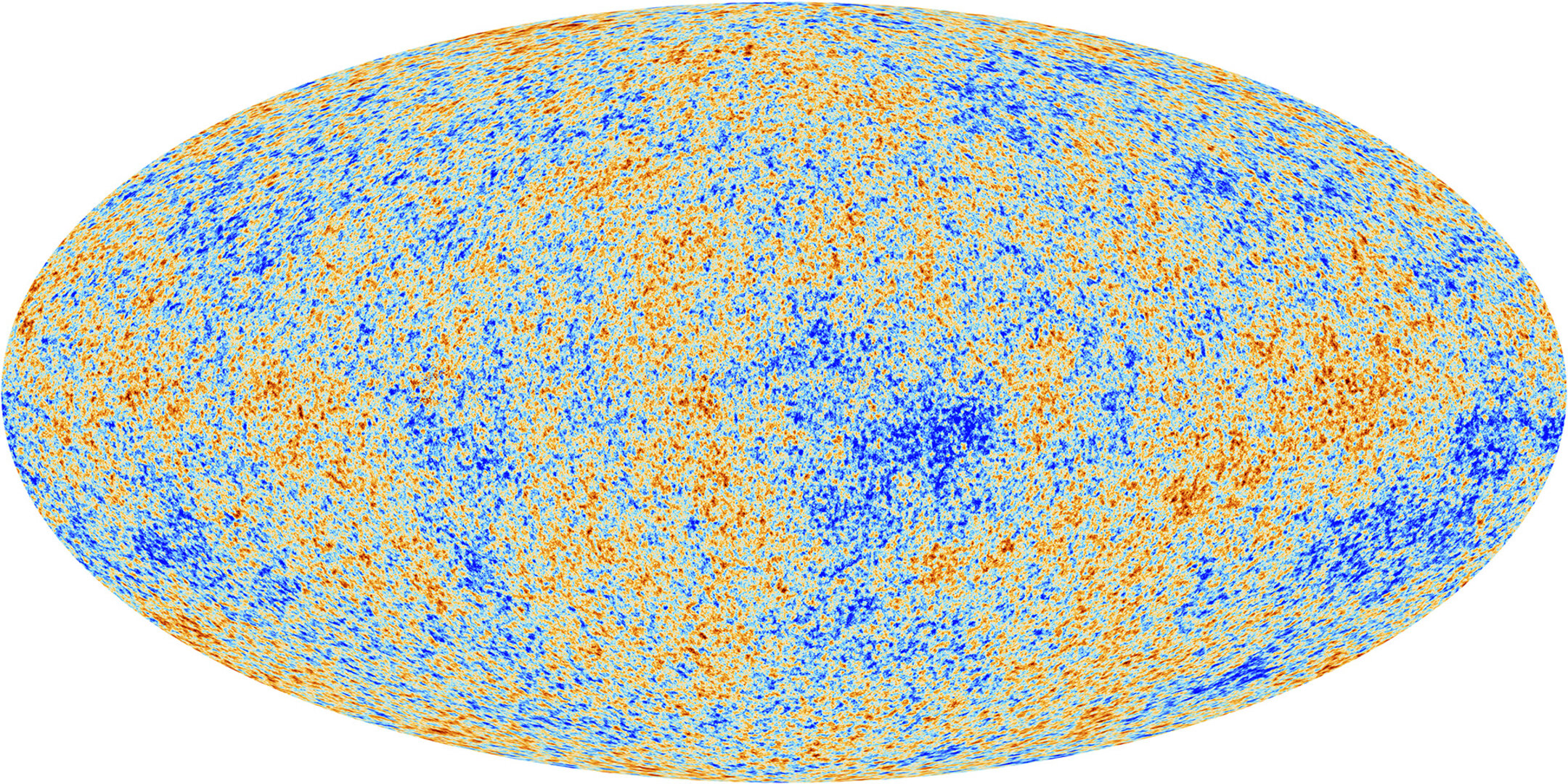
Cosmic Microwave Background (CMB)--Planck observations showing
temperature fluctuations
about the average temperature 2.73 K of
about ± 0.0001 K. The above picture was made by subtracting the average temperature 2.73 K,
and the dipole temperature anisotropy from the complete image
to show the fluctuations. |
F. 106 → 109 years, Stars, Galaxies,
and Large-Scale Structure Formation
|
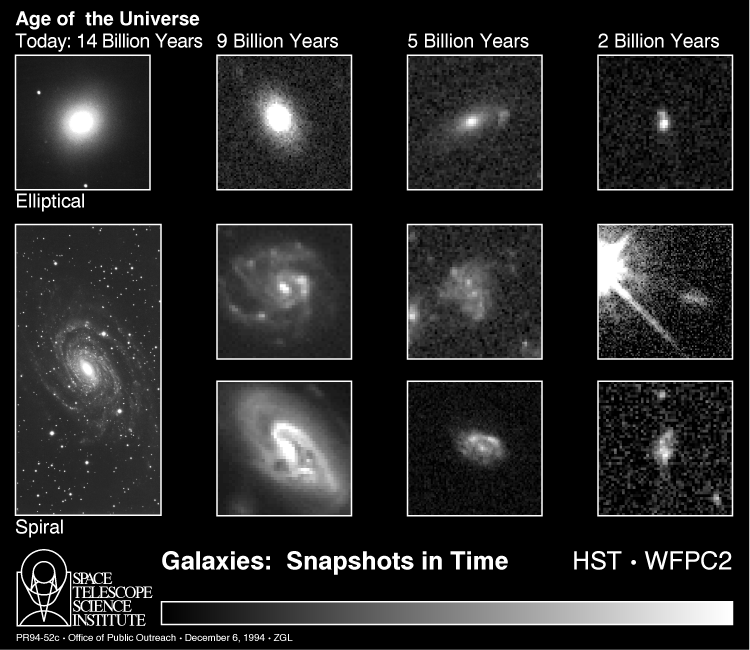
|
Protogalaxies begin to form. This may be annoying since
the clumps of matter and the
clumps of the clumps of overdense matter will distort the CMB.
The reason is that if these clumps are formed by the attraction of
gravity, then such large overdensities take a fairly long time to form
and will be visible during Recombination, the time of CMB formation.
If the Universe was only normal
matter, the observed variations in the CMB are too small
to explain the observed structure in the Universe. This is reconciled
by the existence of Dark
Matter.
This means that the overdense regions could start
growing earlier in the evolution of the Universe without showing up in the
temperature fluctuations; the origin of the
seeds which eventually lead to the current structure in the Universe in fact
has its origins in Inflation.
Currently,
the largest structures in the Universe are consistent with the
imperfections seen in the CMB in this scenario.
If we see much larger structures, then there will be trouble.
Recent results
from the Webb telescope (see Current Events on
course homepage) finds massive young galaxies. It is not that the galaxies
are forming too fast, The problem is that these
galaxies are so massive that nearly every available normal atom must go into
galaxy formation.
Current models suggeset that at most around 10 % of the
atoms go into galaxy formation. This could be a problem for how we
believe galaxies form.
|
G. 1 billion years → 3 billion years
|
Quasars and some radio galaxies become detectable
H. 3 billion years → 13.7 billion years and Dark
Energy Era
|

I. 13.7 billion years →
End |
|
 |
The ultimate fate of the Universe falls into three
categories: (i) the Big Rip; (ii) Continual expansion to
Big Freeze; and
(iii) the Big Crunch, depending upon whether
Ω
is > 1 → the Big Crunch, Ω < 1 →
Continual
expansion, or Ω = 1 → stops after an infinite
amount of time has elapsed if Ωm = 1 or continual
expansion if ΩΛ = 1.
The Big Rip is the ultimate fate of the Universe
if the dark energy density increases
as the Universe expands. |
|
|
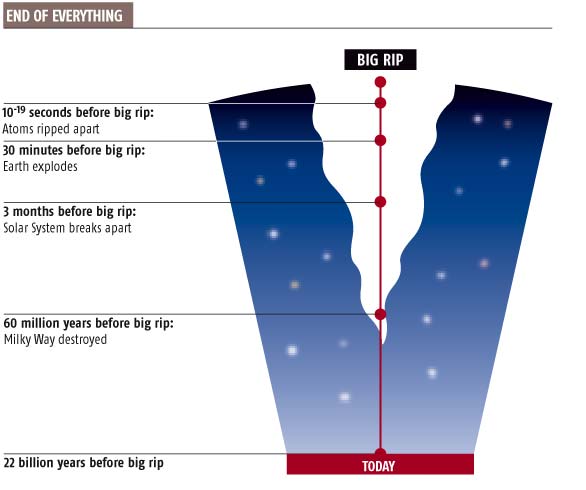
| Big Rip
For certain models of dark energy, the rate
at which the Universe expands increases
leading to an exponentially growing rate for expansion for
the Universe. The resulting rapid expansion is so fast that it
will tear apart all structure in the Universe after a finite amount
of time has elapsed.
For the calculation shown to the left, the
The Big Rip occurs after ~22 billion
years. Although a long time into the future,
The Big Rip happens
on a much shorter timescale than the effects discussed above.
We expect The Big Rip
to take place in models where the
density of dark energy increases
as the Universe
expands.
|
Return to Home Page
|

